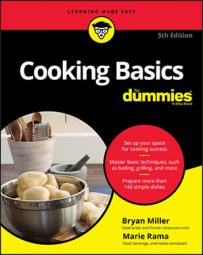To chop or mince, hold the knife handle in a comfortable manner and cut the food into thin strips. Then cut the strips crosswise (as thickly as desired), rocking the blade with your hand and applying pressure on top. Your best bet is to grip the handle with one hand and place your other hand on top of the blade.
Chopping an onion
Want to practice chopping? Many recipes call for chopped onions, so they’re a good place to start. Follow these step:-
Chop off the stem, and then cut the onion in half lengthwise through the bulbous center and peel back the papery skin.
Leave the root end intact. As you slice through the onion, the intact root end holds the onion half together while you slice and chop.
-
Place each half cut-side down and, with your knife tip just in front of the root end, slice the onion lengthwise in parallel cuts, leaving 1⁄8to@@bf1/4 inch between the slices.
-
Make several horizontal cuts of desired thickness, parallel to the board.
-
Cut through the onion crosswise, making pieces as thick as desired.
-
Finally, cut through the root end and discard.
![[Credit: Illustration by Elizabeth Kurtzman]](https://www.dummies.com/wp-content/uploads/454348.image0.jpg) Illustration by Elizabeth Kurtzman
Illustration by Elizabeth Kurtzman
No matter how you slice it, an onion releases intense flavor and juice, which is why so many recipes call for chopped or minced onion. The fumes they emit when sliced raw, however, can be irritating to the eyes. To minimize chopped onion tears, use a sharp knife that reduces cutting time, and frequently rinse off the onion in cold water as you go. Better yet, have someone else cut it.
Mincing garlic
Mincing garlic simply means chopping it very finely.First, a quick explanation of terms: In your grocery store, you find garlic bulbs. (Buy garlic that feels firm and hard, not soft.) A bulb is covered by papery skin. When you peel it off, you discover that the bulb contains multiple cloves with thin skins. If you have difficulty removing individual cloves, take a butter knife and pry them out. Then, here’s what you do:
-
Peel the cloves.
To help you get the skin off easily, set the cloves on your cutting board, and lay your chef’s knife across them with the blade facing away from you. Hold the knife handle with one hand, and use your other hand to whack the side of the blade above the cloves. Doing so should break the skins and let you slip them off easily.
-
Hold the garlic clove on the cutting board, with the knuckles of your index finger and middle finger leaning against the side of the knife blade.
Keep your fingertips folded inward to prevent cutting yourself.
-
Keeping the tip of your knife on the cutting board, pump the handle up and down while you move the clove under the blade.
You’ve probably seen this technique used by the pros on cooking shows.
-
Slowly move your knuckles toward the other end of the garlic as you mince.

